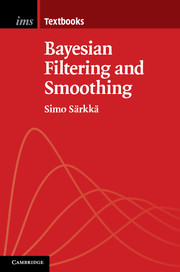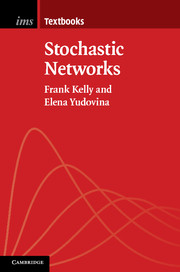Refine search
Actions for selected content:
980 results in Applied probability and stochastic networks
Index
-
- Book:
- Markov Chains and Dependability Theory
- Published online:
- 05 July 2014
- Print publication:
- 12 June 2014, pp 277-278
-
- Chapter
- Export citation
7 - Linear combination of occupation times – performability
-
- Book:
- Markov Chains and Dependability Theory
- Published online:
- 05 July 2014
- Print publication:
- 12 June 2014, pp 160-187
-
- Chapter
- Export citation
9 - Simulation techniques
-
- Book:
- Markov Chains and Dependability Theory
- Published online:
- 05 July 2014
- Print publication:
- 12 June 2014, pp 201-229
-
- Chapter
- Export citation
Contents
-
- Book:
- Markov Chains and Dependability Theory
- Published online:
- 05 July 2014
- Print publication:
- 12 June 2014, pp v-viii
-
- Chapter
- Export citation
8 - Stationarity detection
-
- Book:
- Markov Chains and Dependability Theory
- Published online:
- 05 July 2014
- Print publication:
- 12 June 2014, pp 188-200
-
- Chapter
- Export citation
3 - Continuous-time Markov chains
-
- Book:
- Markov Chains and Dependability Theory
- Published online:
- 05 July 2014
- Print publication:
- 12 June 2014, pp 65-93
-
- Chapter
- Export citation
5 - Sojourn times in subsets of states
-
- Book:
- Markov Chains and Dependability Theory
- Published online:
- 05 July 2014
- Print publication:
- 12 June 2014, pp 125-147
-
- Chapter
- Export citation
4 - State aggregation
-
- Book:
- Markov Chains and Dependability Theory
- Published online:
- 05 July 2014
- Print publication:
- 12 June 2014, pp 94-124
-
- Chapter
- Export citation
References
-
- Book:
- Markov Chains and Dependability Theory
- Published online:
- 05 July 2014
- Print publication:
- 12 June 2014, pp 271-276
-
- Chapter
- Export citation
2 - Discrete-time Markov chains
-
- Book:
- Markov Chains and Dependability Theory
- Published online:
- 05 July 2014
- Print publication:
- 12 June 2014, pp 26-64
-
- Chapter
- Export citation
1 - Introduction
-
- Book:
- Markov Chains and Dependability Theory
- Published online:
- 05 July 2014
- Print publication:
- 12 June 2014, pp 1-25
-
- Chapter
- Export citation
Frontmatter
-
- Book:
- Markov Chains and Dependability Theory
- Published online:
- 05 July 2014
- Print publication:
- 12 June 2014, pp i-iv
-
- Chapter
- Export citation
6 - Occupation times of subsets of states – interval availability
-
- Book:
- Markov Chains and Dependability Theory
- Published online:
- 05 July 2014
- Print publication:
- 12 June 2014, pp 148-159
-
- Chapter
- Export citation
10 - Bounding techniques
-
- Book:
- Markov Chains and Dependability Theory
- Published online:
- 05 July 2014
- Print publication:
- 12 June 2014, pp 230-270
-
- Chapter
- Export citation

Bayesian Filtering and Smoothing
-
- Published online:
- 05 June 2014
- Print publication:
- 05 September 2013

Stochastic Networks
-
- Published online:
- 05 June 2014
- Print publication:
- 27 February 2014
2 - Queueing networks
-
- Book:
- Stochastic Networks
- Published online:
- 05 June 2014
- Print publication:
- 27 February 2014, pp 22-48
-
- Chapter
- Export citation
Appendix D - Foster–Lyapunov criteria
-
- Book:
- Stochastic Networks
- Published online:
- 05 June 2014
- Print publication:
- 27 February 2014, pp 210-216
-
- Chapter
- Export citation
Part I
-
- Book:
- Stochastic Networks
- Published online:
- 05 June 2014
- Print publication:
- 27 February 2014, pp 11-12
-
- Chapter
- Export citation
6 - Effective bandwidth
-
- Book:
- Stochastic Networks
- Published online:
- 05 June 2014
- Print publication:
- 27 February 2014, pp 133-148
-
- Chapter
- Export citation
